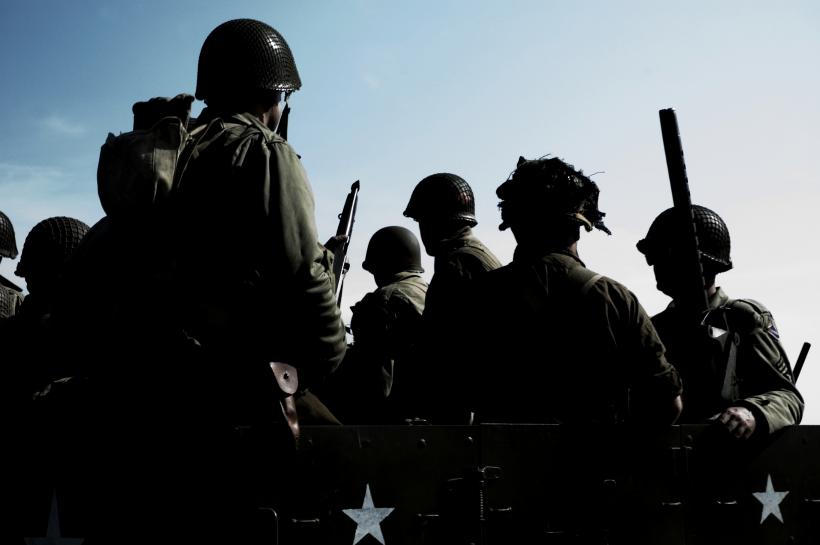
It’s a week of momentous international (rather depressing) anniversaries. Wednesday marked the 25th anniversary of the Tiananmen Square massacre in China, and today is the 70th anniversary of the World War II D-Day landings at Normandy. Needless to say this historic day is a big deal for most of the Western world, and a whole slew of European and American VIPs are attending commemoration ceremonies today in France.
Here’s a brief recap: On June 6, 1944, almost 160,000 Allied troops crossed from England to storm five beaches in German-occupied France. The invasion incurred a heavy death toll, but succeeded in turning the tides against Nazi Germany—fist pump!—who would finally surrender in May 1945.
D-Day is clearly one of the most well-known and discussed events of the war. And with that status, there have inevitably arisen various myths about history’s biggest amphibious assault. So here we’re separating fact from fiction, as argued by historian and BBC documentary film-maker James Holland.
MYTH: D-Day Was Predominantly an American Operation
REALITY: As iconically American as movies and TV shows make it seem, D-Day was definitely an Allied effort. In fact, Holland argues that if anything, Britain took the lead. Yes, Gen. Dwight D. Eisenhower—the supreme Allied commander—was American, but his deputy and four key commanders were all British, and the overall plan primarily came from the tea-touting Brits.
Of the 1,213 warships involved, 200 were American and 892 were British; of the 4,126 landing craft involved, 805 were American and 3,261 were British. Catching the trend? Further, casualties across the American and British beaches were similar in number.
Of course, none of this diminishes the massive effort and casualty toll on the U.S. during the operation. And it should be noted that the initial slaughter of soldiers at the first invasion point at Omaha beach—which may have also been the most harrowing—consisted primarily of Americans.
MYTH: American Capabilities Took a Hit with the D-Day Campaign
REALITY: By the end of World War II the United States had the most-capable armed services in the world (new world order time!), and American ingenuity during the 77-day Normandy campaign actually provided critical advancement in equipment and techniques for the rest of the war.
Prime example: At the start of the campaign, Americans unexpectedly found themselves fighting through difficult Norman terrain that included thick hedges and narrow sunken lanes. Not ideal for trafficking 30-ton American Sherman tanks; but ever-so ideal for German ambushes.
Needless to say, the situation was sticky, but leave it to invention-happy Americans to devise a clever solution. A U.S. sergeant recycled German beach obstacles for use as a hedge-cutting tool at the front of a Sherman (making him the original hipster). Within a couple weeks the device had been fitted to 60% of Shermans in Normandy, and the U.S. pressed merrily on its German-chasing way.
The campaign also saw major improvements in air support and in coordination between different tactical units. Medical services advanced to the point that one in four casualties returned to the battlefield after treatment—a remarkable feat for technology of 1944.
MYTH: German Soldiers Were Better Trained Than Their Allied Counterparts
REALITY: At the start of World War II the best German units were solidly dominant over their Allied opposition, but come D-Day, things were starting to breakdown both in the German fatherland, and on the front. Even German fighting groups prized for their training and ability—including paratroopers and elite tactical teams—came to experience extreme shortages, skimpy training and general desperation toward the end of the war.
So how did the Germans resist for so long during the D-Day campaign? As Holland oh-so-gently explains it:
The best analogy is with more recent conflicts like Afghanistan or even Vietnam, when Western forces . . . struggled to defeat a massively inferior enemy. As the Taliban have shown, it is very difficult to completely defeat your enemy if they don't want to be defeated. The only way to do that is to kill them all.
Likewise, Germans remained very dangerous with a significant reserve of powerful weapons, combined with fierce determination arising from Nazi indoctrination and nationalistic duty. Of course, there was also the threat of execution for deserters. In World War I the Germans executed 48 men for desertion; during World War II the figure rose to 30,000. Hard to catch a break in Hitler’s Germany.
So there you have it—D-Day deconstructed. Aren’t you glad you’ll now be able to counter your uncle’s (totally deluded)—and inevitable!—war lectures at this summer’s family barbecue?
Image: Thinkstock






